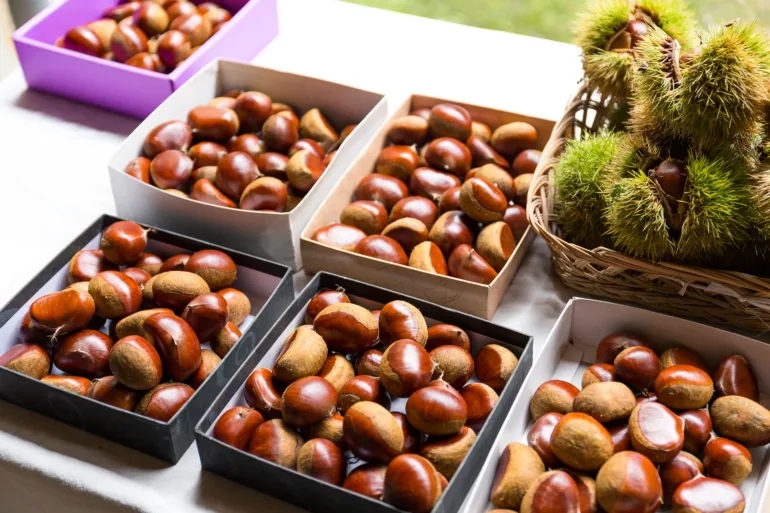Autumn is the time of chestnuts, when the air smells of roasted chestnuts and you can't wait to roast them at home. But if you've ever bought a chestnut in a store, you know that many things can happen - from rotten to moldy chestnuts. So how do you ensure that you choose fresh and tasty chestnuts, without unpleasant surprises?
How to check the freshness of chestnuts? When you get to the store, there's a whole mountain waiting for you chestnuts, but how to identify the right ones that will be great for baking or cooking? Here are some simple tricks that will help you with this.
1. Check the shell
A fresh chestnut has a shiny, smooth shell without cracks or visible damage. If the shell is matted, with wrinkles or even holes, it is probably already old or attacked by pests. Such a chestnut will not be good either for cooking or baking, as it will be dry and tasteless.
2. Feel the weight of the chestnut
Chestnuts that are fresh should be heavy for their size. If you take a chestnut in your hand and it feels light, this is a sign that it is dry or even rotten inside. Fresh chestnuts contain a lot of moisture, so they should be firm and not echo empty in the shell.

3. Shake it and listen
A fresh chestnut must be tightly closed in its shell. If you shake it slightly and you hear something rattling inside, it means that the kernel has shrunk and the chestnut is old or dried. Such chestnuts will be bitter and difficult to eat, so avoid them.
4. The smell of chestnuts
Smell is one of the best indicators of freshness. Fresh chestnuts have a faint, pleasant nutty smell, while rotten or old chestnuts give off an unpleasant, sour smell. If you already detect suspicious smells in the store, immediately leave the chestnuts in the basket.
Common problems with chestnuts from the store
Despite the fact that you follow all the advice, sometimes it still happens that you open a bag of chestnuts at home and are surprised by an unpleasant reality. Here are the most common problems that can happen to you with "regular" store-bought chestnuts:
Mold
If chestnuts have not been stored properly, mold can develop, which you can see as gray or white spots on the shell. Such chestnuts are inedible and must be thrown away immediately, as mold can affect health.
Rot
When you cut into a chestnut and the inside is black or dark brown, this is a clear sign of rot. The cause is often excessive humidity or improper storage. Even if the shell appears undamaged, rotting is a problem that can only be discovered at home.
Chestnut pests
Yes, unfortunately chestnuts are also often victims of various pests. If you see small holes in the shell, this is a sign that the chestnuts have been attacked by insects. It is best to throw away such chestnuts, as the inside is also probably damaged.
Dryness
Chestnuts that have been on the shelf for too long or have not been stored properly will become dry. Such chestnuts are not useful, as they will remain hard and tasteless when cooked or baked. Chestnuts that are too dry also have very little nutritional value.
How to properly store chestnuts at home?
When you buy a fresh chestnut, it is very important to store it properly, because it contains a lot of water (up to 60 %) and spoils quickly. Here are some tips to keep chestnuts fresh and useful for a long time at home:

Storage in the refrigerator
Store fresh chestnuts in the refrigerator, preferably in the vegetable drawer, where the humidity is the highest. The best temperature for storing chestnuts is between 0 and 4 °C, and ideally around 1-2 °C. Use a perforated plastic bag or a paper bag that allows for ventilation, as mold can develop in closed plastic bags due to excessive moisture. Chestnuts can last up to two or three weeks under these conditions.
Freezing chestnuts
If you don't plan to use the chestnuts soon, you can also freeze them. Before that, clean it, dry it and store it in a freezer bag, from which you remove all the air. Chestnuts stored in this way can last up to six months. If you want, you can also freeze it cooked.
Store in a dry place
If you don't have room in the refrigerator, you can also store chestnuts in the basement or another cool, dry place with good air flow. The temperature should be between 4 and 10 °C, and the humidity around 60 %. In this case, regularly check whether signs of mold or rot have appeared.
Additional tip: Before baking, soak the chestnuts in water
Before roasting the chestnuts, it is good to soak them in water for a while. This will make it easier for the chestnuts to peel, and you will also be able to quickly tell from the water which chestnuts are not good - they will float to the surface, because they are empty or rotten inside.
Chestnuts are a real autumn delicacy, but only if they are fresh and of good quality. With the right knowledge and attention, you can always choose the best specimens in the store and avoid unpleasant surprises. The next time you buy chestnuts, remember these tips - your baking will definitely be successful!






